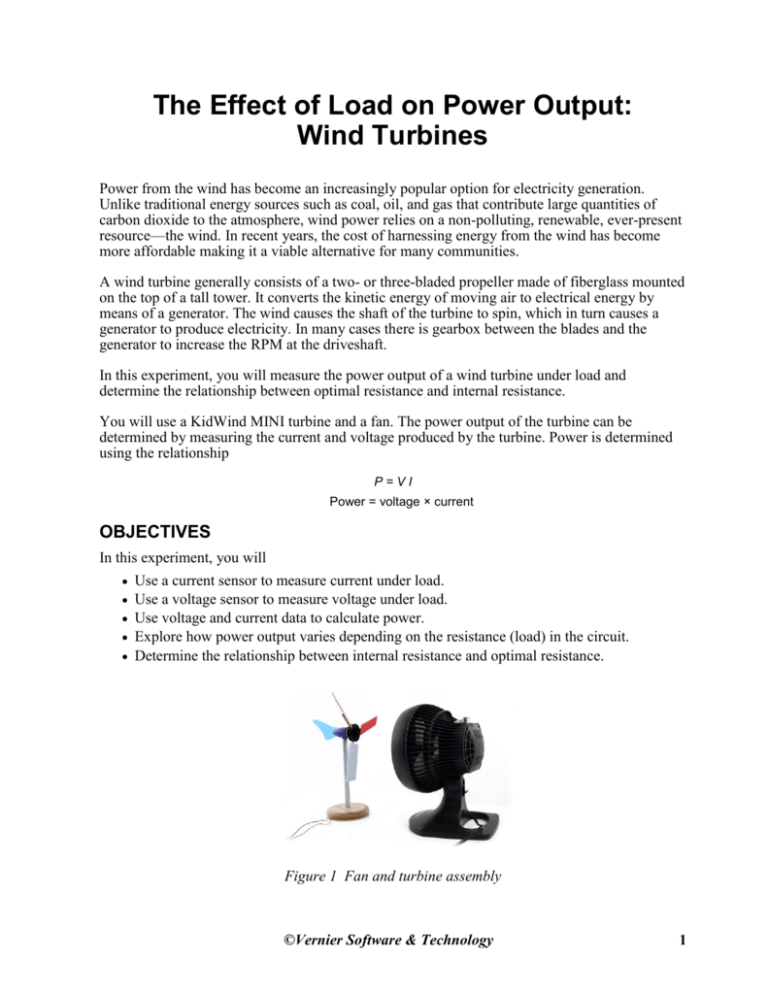Student Guide PDF
advertisement

The Effect of Load on Power Output: Wind Turbines Power from the wind has become an increasingly popular option for electricity generation. Unlike traditional energy sources such as coal, oil, and gas that contribute large quantities of carbon dioxide to the atmosphere, wind power relies on a non-polluting, renewable, ever-present resource—the wind. In recent years, the cost of harnessing energy from the wind has become more affordable making it a viable alternative for many communities. A wind turbine generally consists of a two- or three-bladed propeller made of fiberglass mounted on the top of a tall tower. It converts the kinetic energy of moving air to electrical energy by means of a generator. The wind causes the shaft of the turbine to spin, which in turn causes a generator to produce electricity. In many cases there is gearbox between the blades and the generator to increase the RPM at the driveshaft. In this experiment, you will measure the power output of a wind turbine under load and determine the relationship between optimal resistance and internal resistance. You will use a KidWind MINI turbine and a fan. The power output of the turbine can be determined by measuring the current and voltage produced by the turbine. Power is determined using the relationship P=VI Power = voltage × current OBJECTIVES In this experiment, you will Use a current sensor to measure current under load. Use a voltage sensor to measure voltage under load. Use voltage and current data to calculate power. Explore how power output varies depending on the resistance (load) in the circuit. Determine the relationship between internal resistance and optimal resistance. Figure 1 Fan and turbine assembly ©Vernier Software & Technology 1 MATERIALS Vernier data-collection interface Logger Pro or LabQuest App Vernier Differential Voltage Probe Vernier Current Probe 10, 30, 51 and 100 resistors connecting wires KidWind MINI Turbine fan PROCEDURE 1. Set up the fan and the wind turbine as shown in Figure 1. The turbine should be about 15 cm from the fan. Line up the center of the fan with the center of the turbine blade hub. 2. Connect the Current and Voltage Probes to the datacollection interface. Choose New from the File menu. The default data-collection parameters work well for this experiment. 3. Connect the turbine, 10 resistor, wires, and clips as shown in Figure 2. The T in the circuit diagram is the wind turbine. Take care that the red lead from the turbine and the red terminal of the Current Probe are connected. 4. Zero the Current Probe and the Voltage Probe. a. With no current flowing and with no voltage Figure 2 applied, wait for the readings on the screen to stabilize. b. When the readings on the screen stabilize, choose Zero►All Sensors from the Sensors menu. The readings for both sensors should be close to zero. 5. Since the direction of spin of the turbine depends on the design of the blades, you’ll need to check to see that both the current and voltage readings are positive. a. Turn on the fan. b. Look at the meter for the live readouts and note whether either reading is negative or zero. c. If the current reading is negative, disconnect the alligator clips from the wires on the turbine and switch them. d. If the voltage reading is negative or zero, unclip the voltage probe clips and switch them. 6. Turn on the fan to the high setting. Wait for 60 seconds until the fan and the turbine blades reach a constant velocity. Leave the fan running until you are completely finished collecting data. 7. Start data collection. 2 The Effect of Load on Power Output: Wind Turbines 8. When data collection is complete, determine the average current and voltage readings for the run. a. b. c. d. Choose Statistics►Current from the Analyze menu. Record the mean current reading in your data table. Choose Statistics►Voltage from the Analyze menu. Record the mean voltage reading in your data table. 9. Collect a total of four runs of data for the 10 Ω resistor load. 10. Repeat Steps 7–9 with a 30 Ω resistor substituted for the 10 Ω resistor. Be careful not to change the location of the turbine or fan between trials. 11. Repeat Steps 7–9 with a 51 Ω resistor. 12. Repeat Steps 7–9 with a 100 Ω resistor. DATA AND CALCULATIONS Resistance Run (Ω) 10 Average Voltage (V) Average Current (I) Power (W) 1 2 3 4 Average Power 30 1 2 3 4 Average Power 51 1 2 3 4 Average Power 3 100 1 2 3 4 Average Power 1. Calculate the output power for each trial. 2. Calculate the average power for each resistance. 3. Create a graph of output power vs. resistance. PROCESSING THE DATA 1. Does power output remain the same or vary depending on resistance? 2. What is the optimal resistance, the resistance at which there was a maximum power output, for your wind turbine? 3. What is the internal resistance of your wind turbine? You can determine this by using an ohmmeter. Your teacher may provide you with this number. 4. How does the internal resistance of your wind turbine compare to the optimal resistance for power output? 5. In this experiment you held the wind speed constant as you collected power output data. If you varied the wind speed, what effect would that have on the power output? EXTENSION 1. Do an internet search to learn about maximum power point trackers. What is a maximum power point tracker, MPPT, and what does it do? Why are they important to renewable energy devices such as wind turbines and solar panels? 4








